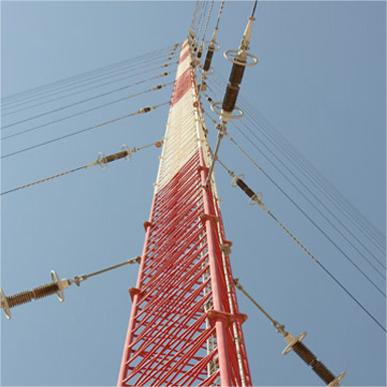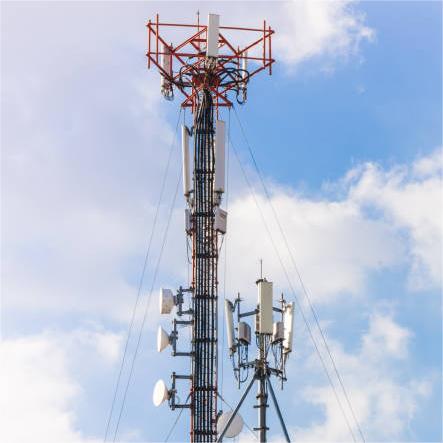A self-supporting tower, also known as a free-standing tower or a lattice tower, is a type of structure used to support antennas, communication equipment, and other infrastructure for wireless communication networks. Unlike guyed towers that rely on guy wires for stability, self-supporting towers are designed to stand on their own without external support.

Key Features of Self-Supporting Towers:
1. Lattice Structure: Self-supporting towers are constructed using a lattice framework composed of steel or other suitable materials. The lattice structure consists of interconnected triangular or square sections that provide strength, stability, and flexibility.
2. Sturdy Design: Self-supporting towers are engineered to withstand wind loads, seismic forces, and other environmental factors that may impact the structure. The lattice design offers inherent strength and allows for efficient distribution of loads throughout the tower.
3. Height and Versatility: Self-supporting towers can be built to various heights, ranging from tens to hundreds of meters, depending on the specific requirements of the communication network. Their versatility makes them suitable for a wide range of applications, both in urban and rural areas.
4. Multiple Platforms: Self-supporting towers often feature multiple platforms or levels at different heights, allowing for the installation of antennas, microwave dishes, and other communication equipment. The platforms provide convenient access for maintenance and equipment installation.
5. Site Adaptability: Self-supporting towers can be installed in various locations, including open fields, rooftops, and urban areas. They are adaptable to different terrains and can be designed to accommodate specific site conditions and constraints.
6. Easy Installation and Maintenance: Self-supporting towers are typically modular in design, allowing for easier transportation, assembly, and installation. The lattice structure also facilitates maintenance and repair work, as individual sections or components can be accessed and replaced if necessary.
Self-supporting towers are widely used in telecommunications for applications such as cellular networks, TV and radio broadcasting, and public safety communications. They provide reliable support for antennas, enabling the transmission and reception of wireless signals over long distances. The choice of a self-supporting tower is based on factors such as coverage requirements, site conditions, tower height, and regulatory considerations.

Self-supporting towers and guyed towers are two common types of structures used in the field of telecommunications to support antennas and communication equipment. While both types have their advantages and considerations, here are some key advantages of self-supporting towers over guyed towers:
1. Stability and Structural Integrity: Self-supporting towers are designed to stand on their own without relying on guy wires for support. This inherent stability eliminates the need for extensive guy wire systems and reduces the complexity of installation. Self-supporting towers can withstand wind loads, seismic forces, and other environmental factors more effectively due to their sturdy lattice design.
2. Space Efficiency: Self-supporting towers require less horizontal space compared to guyed towers. They have a smaller footprint as they do not need guy wire anchors or extensive guy wire systems that can occupy a significant area around the tower. This space efficiency is particularly advantageous in areas with limited land availability, such as urban environments.
3. Aesthetic Considerations: Self-supporting towers often have a more visually appealing appearance compared to guyed towers. The lattice structure of self-supporting towers can be designed to blend into the surroundings or be less obtrusive, making them more suitable for areas with aesthetic restrictions or zoning regulations.
4. Installation Flexibility: Self-supporting towers are generally easier and quicker to install compared to guyed towers. The modular design of self-supporting towers allows for efficient transportation and assembly. They can be installed in various locations, including rooftops, open fields, and urban areas, providing flexibility in deployment.
5. Maintenance Accessibility: Self-supporting towers typically offer better accessibility for maintenance and equipment installation. The lattice structure allows technicians to easily access different levels or platforms of the tower for repairs, upgrades, or equipment replacement. This accessibility can reduce maintenance costs and downtime.
6. Height Capability: Self-supporting towers can be constructed to great heights, allowing for the installation of antennas at elevated positions. This height capability is advantageous in scenarios where extensive coverage or long-distance communication is required, such as in rural areas or for long-range wireless links.

It's important to note that self-supporting towers also have some considerations. They tend to be more expensive to manufacture and construct compared to guyed towers, especially at greater heights. Additionally, self-supporting towers may have certain limitations in extremely high wind or ice load areas, where guyed towers might provide better options.
Ultimately, the choice between self-supporting towers and guyed towers depends on various factors, including site requirements, available space, regulatory considerations, budget, and specific engineering considerations.
Learn more at www.alttower.com
